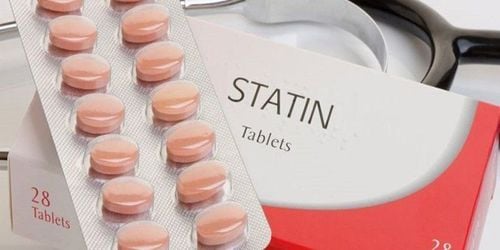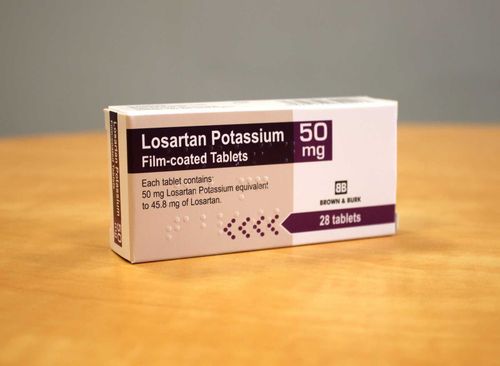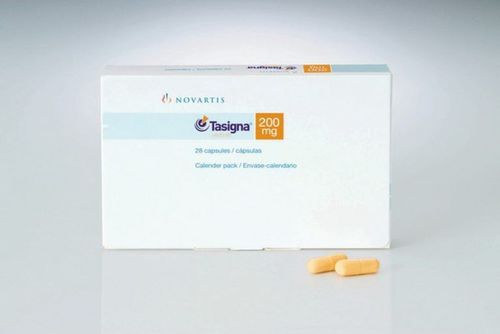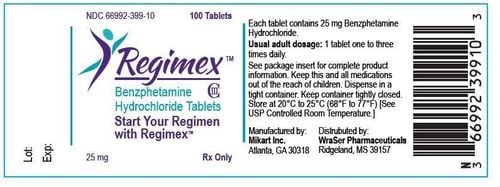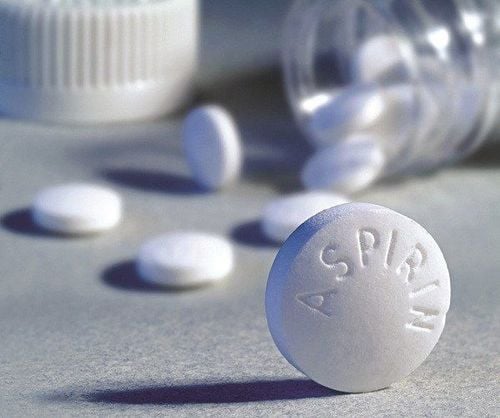This is an automatically translated article.
Pravafen is used as adjunct to diet in patients with moderate or severe hypercholesterolemia, patients with a history of myocardial infarction or unstable angina. Let's learn more about Pravafen drug line through the article below.1. What is Pravafen?
Pravafen belongs to the group of cardiovascular drugs with the main ingredients being Pravastatin sodium 40mg and Fenofibrate 160mg.In addition, each tablet contains other excipients such as:
Ingredients in the capsule: Lactose monohydrate, Microcrystalline Cellulose, Povidon K29-32, Ascorbyl palmitate, Sodium starch glycolate, Tale, Triacetin, Magnesium stearate, Lauroyl macrogolglyderia Typ 1500, Macrogol 20000, Hydroxypropylcellulose. Capsule shell composition: Yellow iron oxide, Black iron oxide, Titanium dioxide, Indigo carmine red, Gelatin. Pravafen is a hard capsule, with a light green body and an olive cap containing a beige-white wax-like mass and one tablet. The drug is packaged in an opaque white HDPE vial containing 30 hard capsules.
2. Indications for taking Pravafen
Pravafen 40 mg/160 mg is used in the following cases:
Indicated for use in combination with nutrition and other non-pharmacological measures such as exercise, weight loss diet effective in patients (types IIa, IIb). Primary prevention: Adjunct to dietary therapy to reduce the risk of cardiovascular death in patients with moderate or severe hypercholesterolemia who are asymptomatic and at high risk for first CVD. Secondary prevention: Adjunctive to overcoming risk factors in patients with a history of myocardial infarction or unstable angina with normal or elevated cholesterol to reduce the risk of death from caused by cardiovascular disease. Post-transplant: Reducing hyperlipidemia in patients taking immunosuppressive drugs after organ transplantation.
3. Dosage - How to take Pravafen
3.1. How to use Pravafen is used for oral primary hypercholesterolemia.
Because the drug is less absorbed when hungry, so it should be taken with a meal.
3.2. Dosage: The recommended dose is 1 tablet of Pravafen/day in the evening. Patients should continue to maintain their established dietary restrictions and exercise regimen prior to initiating treatment.
Preventing the risk of cardiovascular disease: 40mg Pravafen/day.
After organ transplantation: Initial dose of 20mg Pravafen/day in patients receiving immunosuppressive drugs. Depending on the response of the lipid profile, the dose may be increased to 40 mg Pravafen/day under close medical supervision.
Patients should be monitored for response to treatment by measuring serum lipids. Serum lipid levels will usually decrease rapidly with Pravafen treatment. If a satisfactory response is not achieved within 3 months of treatment, the drug should be discontinued. The maximum dose should not exceed 40mg/day.
Elderly > 65 years:
The starting dose of Pravafen should be started after assessment of renal function. The safety data of Pravafen in this population are limited, so it should be used with caution and no dose adjustment of Pravafen is required. Patients with renal impairment:
Pravafen is contraindicated in patients with severe and moderate renal impairment when creatinine clearance < 60 ml/min. Patients with mild renal impairment should start at 10mg/day and adjust dose accordingly. Patients with hepatic impairment:
Pravafen is not recommended for patients with moderate hepatic impairment and is contraindicated in patients with severe hepatic impairment. Patients with mild hepatic impairment should start at 10 mg/day and adjust dose accordingly. Children < 18 years old:
Pravafen is not suitable for use in children with indications for the treatment of mixed dyslipidemia. Combination therapy:
In combination with Colestyramine, Colestipol will increase the lipid-lowering effect on total cholesterol and LDL - cholesterol. Pravafen should be taken 1 hour before or at least 4 hours after taking these drugs. For patients receiving ciclosporin with or without other immunosuppressive agents, treatment should be initiated at a dose of pravastatin sodium 20 mg once daily and dose adjustments to 40 mg should be made with caution. Combination with Protease Inhibitors: There is no dose restriction when combined with the following HIV and HCV protease inhibitors: Atazanavir, Atazanavir, Ritonavir, Darunavir, Ritonavir, Lopinavir, Ritonavir.
4. What should be done in case of an overdose of Pravafen and how to handle it?
There have been reports of a few cases of overdose of Pravastatin, which usually recovered and left no serious sequelae. In case of overdose of Pravafen 40 mg/160 mg, the patient should be given symptomatic and supportive measures when necessary.
Pravastatin: Usually in overdose there are no symptoms and no increase in laboratory parameters. There is no specific antidote for overdosage of Pravastatin, symptomatic treatment and appropriate supportive measures are required. Fenofibrate: There is no specific antidote to Fenofibrate overdose. If an overdose is suspected, symptomatic treatment and appropriate supportive measures are required, hemodialysis for the elimination of Fenofibra is not meaningful.
5. Contraindications to taking Pravafen
Pravafen should not be used in the following specific cases:
Patients with hypersensitivity to Pravastatin sodium and Fenofibrate or to any of its ingredients. Patients with severe hepatic impairment including biliary cirrhosis or active hepatitis including persistent elevations of liver function test values not identified by more than 3 times the upper limit of normal. Young children and children under the age of 18. Patients with moderate and severe renal failure. The patient has been identified to have a phototoxic or photoallergic reaction during treatment with Fibrates and Ketoprofen. Patients with gallbladder-related diseases. Acute or chronic pancreatitis (except acute pancreatitis due to hypertriglyceridemia). Women who are pregnant and breastfeeding. Patients with a history of myopathy and myopathy caused by statins or fibrates, previously identified as having increased creatine phosphokinase above 5 times the ULN on statins.
6. Pravafen drug interactions
Pravafen when combined with some other drugs can cause drug interactions such as:
Pravastatin should not be used in combination with Fibrates including Gemfibrozil, and Fenofibrate due to increased toxicity on the body. If necessary, the patient should be clinically cautious and monitored for Creatinine kinase. Colestyramine/Colestipol: Decreases the bioavailability of pravastatin by approximately 40-50% when co-administered. Pravafen should be taken 1 before taking Colestypol or 1 to 4 hours after taking Colestyramine. Ciclosporin combined with pravastatin can increase the amount of pravastatin in the body up to 4 times. It is necessary to control the clinical and biochemical parameters of the patient when using these two drugs in combination. Warfarin and other anticoagulants: The bioavailability of pravastatin is unchanged when used with Warfarin. Drugs metabolized by Cytocrom P450 in combination with pravastatin are also not metabolized by Cytocrom P450, so there is less increase in plasma concentrations like some other statins when used with these drugs. Especially does not interact with some drugs that are activated or inhibited by CYP3A4 (Verapamil, Diltiazem, Itraconazole, Protease inhibitors, Ketoconazole, grapefruit juice), CYP2C9 inhibitors (Fluconazole). Macrolide antibiotics: Erythromycin and Clarithromycin increase the AUC and Cmax of pravastatin. Colchicine in combination with pravastatin increases the risk of myopathy or rhabdomyolysis. In combination with Niacin and Pravastatin, the risk of skeletal muscle effects may be increased, in which case a dose reduction of Pravastatin should be considered. Protease Inhibitors: Most protease inhibitors inhibit the metabolism of most statins and can significantly increase serum statin concentrations. Concomitant use of lipid-lowering drugs of the statin group with drugs to treat hepatitis C virus (HCV) may increase the risk of muscle damage, kidney failure leading to kidney failure, the most serious is diarrhea skeletal muscle and can be fatal.
7. Side effects when taking Pravafen
Pravafen is well tolerated, has a lower incidence of adverse events and discontinuation than other lipid-lowering agents.
Immune system disorders: Hypersensitivity reactions such as anaphylaxis, lupus-like syndrome, angioedema. Nutritional and metabolic disorders: Aggravation of diabetes and obesity. Psychiatric disorders: Insomnia, nightmares Central nervous system: Dizziness, headache, sensory disturbances. Heart disorders, palpitations Gastrointestinal disorders: Abdominal bloating, abdominal pain, upper abdominal pain, constipation, diarrhea, dry mouth, belching, flatulence, nausea, vomiting, abdominal discomfort Liver disorders Biliary: Increased Transaminase, liver pain, increased Gammaglutamyl transferase, jaundice, hepatitis, hepatocellular necrosis. Skin and subcutaneous tissue disorders: Skin itching, urticaria, alopecia. Musculoskeletal and connective tissue disorders: Arthralgia, back pain, increased blood creatine phosphokinasa, muscle spasms, musculoskeletal pain, myalgia, extremity pain, paroxysmal myoglobinuria leading to secondary acute renal failure. Renal and urine disorders: Increased blood creatinine, decreased renal creatinine clearance, increased creatinine clearance and renal failure, nocturia. General and local disorders: Asthma, fatigue, pseudo-influenza Subclinical: Increased cholesterol, blood triglycerides, increased low molecular weight Lipoprotein, weight gain. Vision: Double vision, blurred vision
8. Precautions when using Pravafen
Before taking Pravafen, patients need to refer to some of the following notes:
Patients need to have liver enzyme tests before starting statin therapy. Before starting treatment, it is necessary to assess CK levels before starting treatment. The baseline CK concentration can be used as a reference if it is increased later during the combination therapy. It is important to distinguish the case where other potential factors can also cause transient damage to the muscle. If the CK concentration rises significantly to more than 5 times the UNL above baseline, the results should be monitored after 5-7 days. During treatment, CK levels should be checked periodically every three months during the first 12 months of combination therapy and evaluated by a physician. Patients should report unexplained muscle pain, muscle tenderness, muscle weakness, or cramps requiring CK levels to be assessed. As with other lipid-lowering agents, moderate increases in transaminase levels have been reported in some patients treated with Pravastain or Fenofibrate. In the majority of cases, hepatic transaminase levels returned to baseline without discontinuation of treatment. It is recommended that transaminase levels be checked every 3 months for the first 12 months of treatment and evaluated by a physician after initiation of therapy. Patients with elevated levels of Trasaminase should be given special attention and drug therapy should be discontinued if the elevation of Aspartate aminotransferase and Alanin aminotransferase is more than 3 times the ULN continuously. Pravafen should be used with caution in patients with a history of liver disease or heavy alcohol consumption. When using Fenofibrate and Pravastatin in patients can cause pancreatitis and indirect consequences of kidney stone formation or parabile duct leading to bile duct obstruction. Discontinue Pravafen if the patient has an estimated creatinine clearance < 60 ml/min. Use with caution in patients with interstitial lung disease, especially long-term use. If you experience difficulty breathing, dry cough, deterioration of health, fatigue, weight loss or fever, you should stop treatment with Pravafen. If kidney stones are present or suspected, treatment with Pravafen should be discontinued. There are data to show that Statins are the culprits of elevated blood glucose levels in some patients at high risk for future diabetes, which can cause elevated blood glucose levels. However, statins should not be stopped because they have been shown to reduce cardiovascular risk. The drug should be used with caution in patients at high risk for diabetes. Pravafen should not be used in patients with a history of galactose intolerance, Lapp lactase deficiency or glucose-galactose malabsorption. Pravafen should only be used in women of childbearing age when it is certain that they are not pregnant and do not have very high blood cholesterol that has not responded to other medications. In case the patient has a history of galactose intolerance, lactase deficiency or glucose-galactose malabsorption, the drug should not be used because it contains lactose. Pravastatin should not be used during pregnancy. If the patient plans to become pregnant or becomes pregnant, the doctor or pharmacist should be informed immediately and pravastatin should be discontinued because of the risk to the fetus. Small amounts of pravastatin are excreted in human milk, so pravastatin is contraindicated in nursing women. Pravafen has no or negligible influence on the ability to drive and use machines. However, the drug should be used with caution because it can cause dizziness and impaired vision during treatment.
Please dial HOTLINE for more information or register for an appointment HERE. Download MyVinmec app to make appointments faster and to manage your bookings easily.




